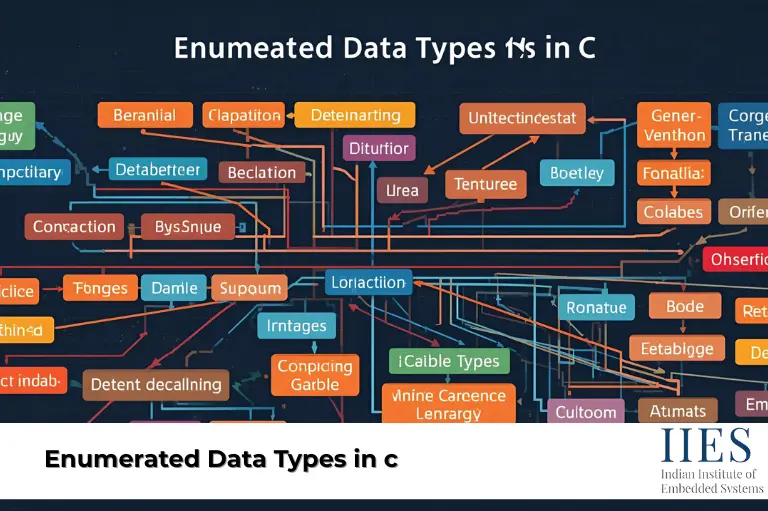
Data types shape how a program works and how readable it is.In Embedded C programming, one special data type — enumerations (enum) — makes code simple, clean, and easier to debug.
Enums help programmers give meaningful names to numbers, which makes the code easier to read and maintain. Instead of using random numbers, you can use named constants that explain their purpose. This is especially useful for beginners and students learning embedded system courses in Bangalore.
Enumerated data types in Embedded C create named constants that improve readability, reduce errors, and make embedded system code easier to manage.
Every programming language uses data types to define what kind of value a variable can hold — numbers, characters, or floating-point values.
Without proper data types, code quickly becomes hard to read, maintain, or scale. That’s where Enumerated Data Types in C shine.
An enumerated data type (enum) is a user-defined type made of named constants. These constants represent integer values but are written with meaningful names instead of numbers.
Example:
enum colors {RED, GREEN, BLUE};This makes your program easier to read than using raw integers.Using Enum in C also improves understanding in embedded c language projects.
In Embedded C programming, enums are declared using the enum keyword followed by a name and a list of constants. This makes variables more readable and meaningful. Proper declaration helps in organizing code and avoiding errors.
enum days {MON, TUE, WED, THU, FRI, SAT, SUN};This way, instead of writing if(day == 2), you can write if(day == WED), which is much easier to understand.
Enums can take automatic values starting from 0 or explicit values assigned by the programmer. Explicit assignment gives better control, especially for hardware-related constants. Using enums this way makes the code clear and predictable.
enum colors {RED, GREEN, BLUE}; // RED=0, GREEN=1, BLUE=2enum colors {RED=1, GREEN=2, BLUE=4};
Enums provide type-checking, unlike macros or simple constants, reducing programming errors. They improve code readability by giving meaningful names to values. Enums also integrate seamlessly with switch case in C for better logic handling.
Embedded systems often have memory and performance constraints. Enums in C help save memory by representing values efficiently and make the code easier to maintain. They also reduce debugging time by providing self-explanatory names.
Example: In microcontroller programs, enums can define states like IDLE, RUNNING, or ERROR.
Switch statements become simpler and less error-prone when used with enums. Each case can clearly correspond to an enum constant. This improves code clarity and ensures that all possible cases are handled correctly.
enum Operation {ADD, SUBTRACT, MULTIPLY, DIVIDE};
void calculate(enum Operation op, int a, int b) {
int result;
switch(op) {
case ADD: result = a + b; break;
case SUBTRACT: result = a - b; break;
case MULTIPLY: result = a * b; break;
case DIVIDE: result = a / b; break;
}
printf("%d\n", result);
}
Using ADD or MULTIPLY improves readability and prevents errors.
Enums make the code self-documenting and easy to understand for other developers. Using meaningful names instead of numbers helps teams work collaboratively. This reduces the time spent figuring out what each value represents.
enum week {MON=1, TUE, WED, THU, FRI, SAT, SUN};if(day == 3) (unclear)if(day == WED) (clear and meaningful)This is especially useful for team projects where multiple people need to understand your logic.Embedded C programming examples emphasize readability.
Always assign meaningful names to enum constants and group related enums together. Using typedef can improve type safety. Following these practices ensures clean, readable, and maintainable code.
typedef for type safety.Avoid unnecessary value assignments, overlapping constants, and skipping typedef. Such mistakes can cause confusion and errors. Careful planning and organization keep the enum usage clean and effective.
typedef, reducing clarity.Being careful with naming and organization prevents these issues in embedded C programming examples.
Enums can represent bit flags to save memory in embedded systems online training. Each constant can represent a single bit, allowing combination of values efficiently. This technique is widely used for permissions and hardware settings.
enum permissions {READ=1, WRITE=2, EXECUTE=4};READ | WRITE = 3 → user has read and write permissions.Enums exist in C++, Java, and Python, though implemented differently.Learning them in Embedded C programming makes it easier to adapt in other languages.
Understanding enums in embedded c language makes it easier to learn their advanced use in other programming languages too.
Enumerated data types in Embedded C developers write clean, readable, and error-free programs. By giving meaningful names to constants, enums reduce confusion, improve maintainability, and make embedded code more reliable for real-world applications.
Enumerated data types (enum) are user-defined types consisting of named constants. They simplify code readability, reduce errors, and are widely used in Embedded C programming.
Enums are declared using the enum keyword followed by a list of constants. Values can be automatic starting from 0 or explicitly assigned for better control in embedded systems online training.
Unlike simple constants or macros, enums provide type-checking and work seamlessly with switch case in C, reducing errors and improving code clarity.
Using meaningful names instead of numbers makes code self-documenting and easier for teams to maintain, a key principle in embedded c programming examples.
Yes, enums integrate perfectly with switch statements, allowing cleaner, error-free decision-making in Embedded C programming.
Avoid random value assignments, overlapping constants, and not using typedef. Proper organization ensures clean and effective use in embedded system courses in Bangalore.
Indian Institute of Embedded Systems – IIES